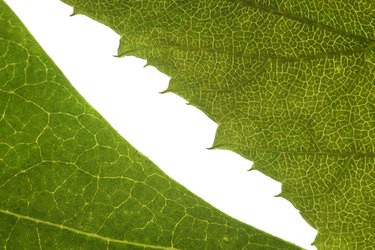Things You'll Need
Rectangular tray with lip
Colorful Play-Doh

When you are teaching small children about basic botany and plant anatomy, you can make the lesson more interesting and entertaining by using Play-Doh to construct a plant cell model. Everything you need to make a Play-Doh plant cell can be found at any toy shop or craft store.
Step 1
Place a rectangular tray in front of you, and press one container of green Play-Doh into the tray. Spread the green Play-Doh around in an even layer, spreading it up onto the lip edges. This represents the cell wall of the plant cell.
Video of the Day
Step 2
Spread out one container of yellow Play-Doh to fill the the center of the plant cell. Spread the Play-Doh out in an even layer. This is the cytoplasm of the plant cell.
Step 3
Form half of a container of blue Play-Doh into a trapezoidal shape, and press it onto half of the plant cell. This is the vacuole of the plant cell.
Step 4
Form one-third of a container of red Play-Doh into a ball; then press the ball flat. Place the flattened ball onto the center of the plant cell. This is the nucleus of the plant cell.
Step 5
Form a quarter-sized piece of pink Play-Doh into a ball; then flatten the ball. Place the pink circle of Play-Doh on top of the nucleus. This is the nucleolus of the plant cell.
Step 6
Form a quarter-sized piece of green Play-Doh into an oval; then flatten it. Place the green oval onto the cytoplasm. Repeat to add on five to six green ovals, which represent the chloroplasts of the plant cell.
Step 7
Form a quarter-sized piece of purple Play-Doh into a spiral; then place the spiral onto the cytoplasm. This represents the golgi body of the plant cell.
Step 8
Form a quarter-sized amount of orange Play-Doh into an oval, then flatten the oval. Place the orange oval onto the cytoplasm, which represents the mitochondria of the plant cell.
Tip
Provide the children with enough materials for each child to construct a plant cell.
Video of the Day